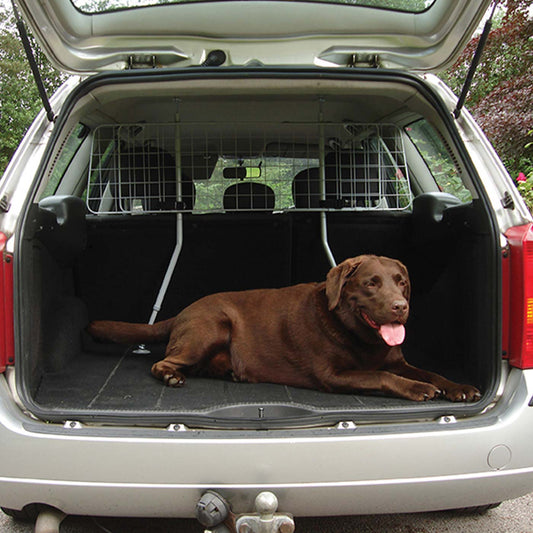Our travel mini series continues this week with Designed for the Road – Dog Car Travel Crates. We get lots of questions about what crate will fit and what size is suitable for certain breeds. The best way to ascertain whether a crate will fit your car and the way you’d like to use it is to measure your boot and cross reference with the measurements on the product listing. We know certain models, but we’re certainly not car experts! Also, the crate may fit your car, but not have room for anything else – it’s best you measure and decide how much room the crate will fill and whether it will fit into your lifestyle…
Ellie-Bo Car Crate – Available in Standard and Deluxe and in two sizes
The Ellie Bo Slanted Car Crate is the crate we get the most questionsabout. A really practical crate that will fit in most cars and suitable for small-medium sized dogs. Ideal for short trips, it will keep your four-legged friend safe when out on the road. Available in two sizes and in either standard or deluxe, the latter having thicker sturdier bars and the addition of a fleece liner in the tray. The small 24” carrier is suitable for toy dogs such as Pugs and Chihuahuas up to the size of a Bedlington Terrier. The Medium 30” is suitable for slightly larger dogs such as Schnauzers, Basset Hounds and Dachshunds. This is just a guide and it’s always best to think about how you will use the crate and how far you will be intending to travel with it. If you’re going on a long journey, then the more room you can offer your pup the better. If your breed is at the larger end of the scale for the size of crate you’re looking at, it may be best to look at other options. As far as, “will it fit in my car?”: for reference, the medium crate in the pictures is shown in a Ford Focus. We definitely suggest measuring your own boot and cross-referencing with the crate dimensions.
Trixie Friends on Tour Dog transport Box
The Trixie Friends on Tour transport box for dogs is ideal for medium to large breeds. It's made from a sturdy metal frame and will fit in most medium sized cars up to the size of a Discovery Sport. A brilliant travel crate option with good air circulation and a non-slip thermo mat included. It has a slanted front so it can really optimise the space available in your boot.
Fabric Pet Carrier by Bunty
A good alternative to a car crate is the Fabric carrier by Bunty. Available in Red or Navy in three sizes. The Bunty carrier features a really sturdy metal frame that clips into place with ease and can fold flat when not in use. The sides are made of mesh offering good ventilation and a window for your pet to see where they’re going; and there’s a fleecy liner inside for your furry friend’s comfort. There are also handy pockets on the outside of the frame where you can store and necessary accessories on your travels and the carry strap has a cushioned pad for comfort. An all-round versatile pet carrier and the small size is suitable for cats and rabbits as well as dogs.
Standard Ellie-Bo Dog Crate
If you have a large car with ample boot space, then the regular Ellie-Bo crates will do the same job as the travel version whilst offering more room for larger dogs. Both the standard and deluxe crates come with a handy carry handle and there are travel bowls available separately to attach inside on longer journeys. These are a good alternative for those with dogs too large for the travel versions and are great on a practical level as you don’t need to buy more than one crate – you can use the same at home and on your travels. Again, do check measurements and cross-reference with the dimensions of your car boot.
Which Dog Travel Crate to choose?
Beyond finding the right size for your pet (and car!) this really comes down to personal preference and which will fit best with your lifestyle and how you intend to use the crate. If you travel long journeys quite often then the more space you can offer your pet the better; if it’s an occasional trip to the vet then space is less important although you do want them to be comfortable. If you have a large breed dog such a Great Dane, then our crates won’t be suitable (unless you drive a van or a bus!). In this case we’d suggest a car cape, or similar, to cover your seats and a harness to secure your dog in the back seat.
If you have further questions about any of the crates mentioned, do get in touch. We are available during office hours on LiveChat and the telephone. Alternatively send us an e-mail to hello@lordsandlabradors.co.uk and we will get back to you as soon as we can. If you already one of these crates, or prefer an alternative method of safe travel, let us know. We like to know which products for you. If you send us a picture we may even feature over on our Social Media channels.































































































